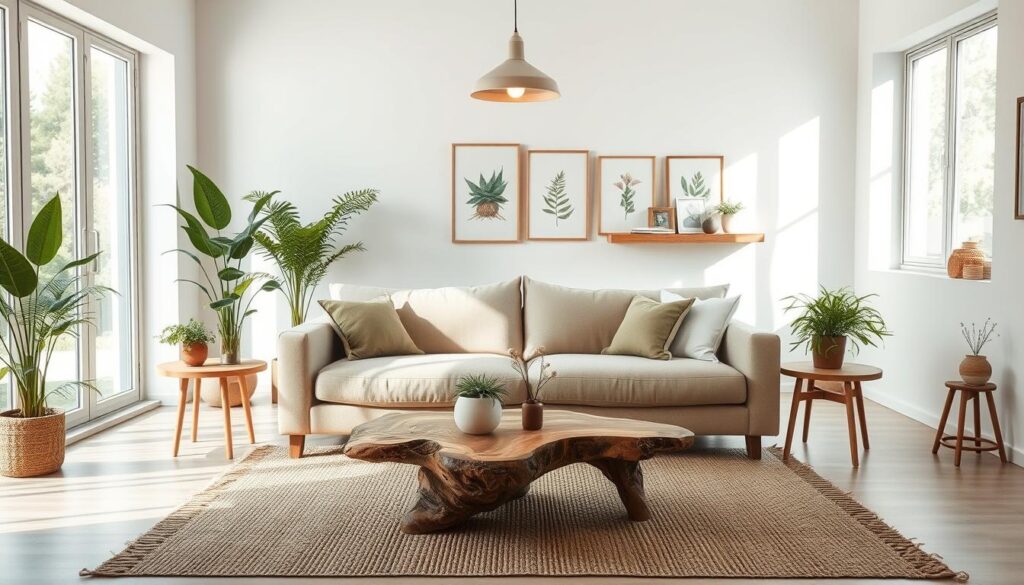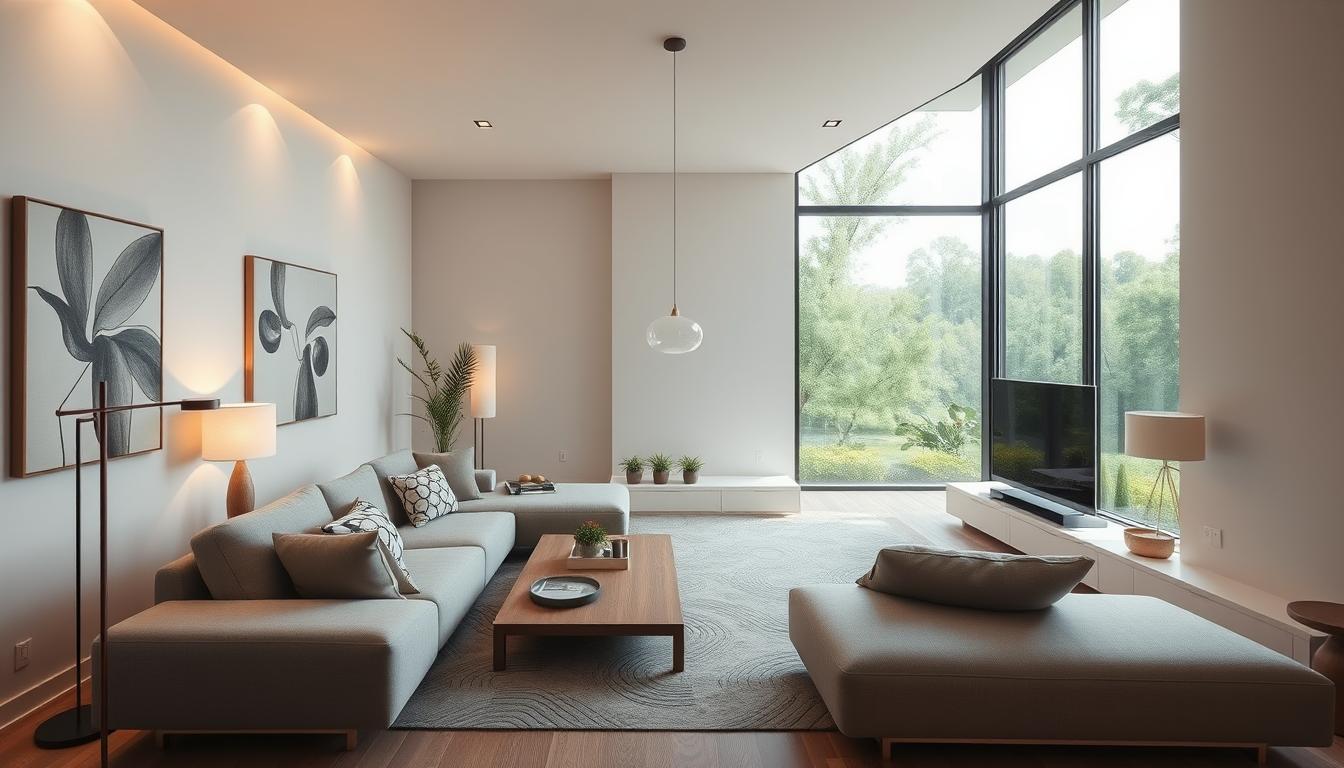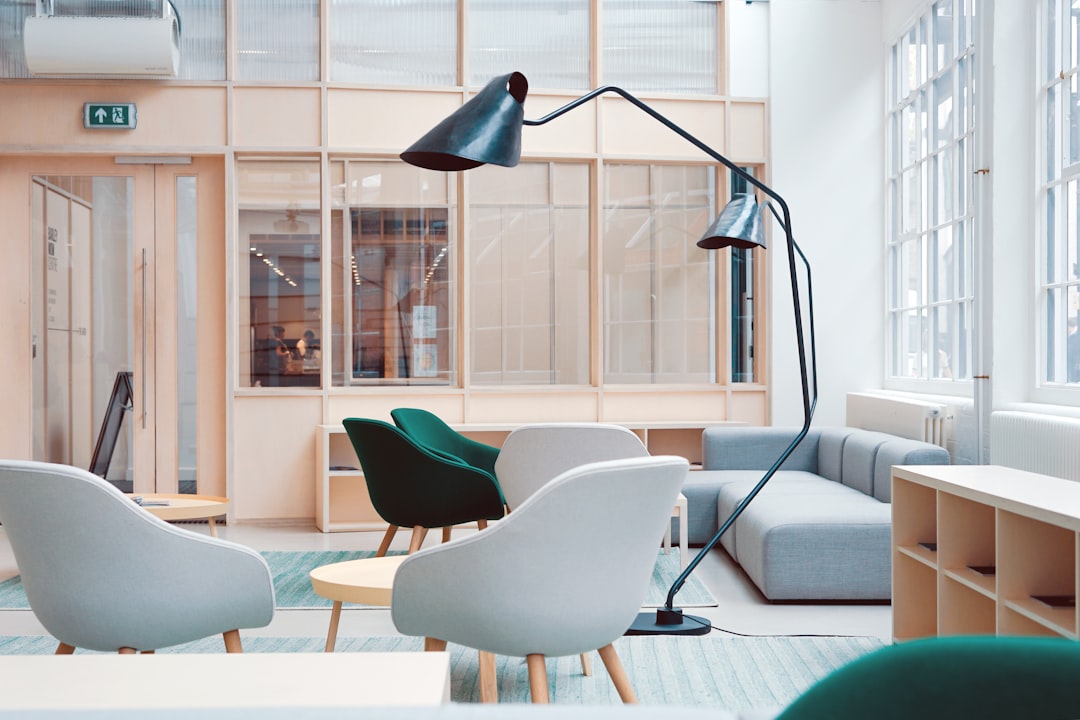Did you know the living room is often called the heart of the home? It’s where we chill, have fun, and bond with loved ones. A stylish living space can really make your home feel welcoming.
We’ll dive into design ideas to make your space both beautiful and useful. We’ll talk about open spaces and green living. For more ideas, check out our article on contemporary living room design to kick off your home makeover.
Key Takeaways
- Create a cozy atmosphere with warm colors
- Use neutral tones as a versatile backdrop
- Optimize furniture placement for interaction
- Layer lighting for a dynamic atmosphere
- Incorporate natural elements for organic beauty
1. Embrace Open Spaces for a Breath of Fresh Air
Open spaces are key in modern living room design. They bring freedom and airflow, making rooms feel bigger and more welcoming. This is especially good for small living room decorating tips, as it reduces clutter and promotes calm.
Create a Cohesive Flow with Open Layouts
To get an open layout, think about the room’s flow. Arrange furniture to make a natural path and keep traffic moving. This makes the room feel cozy yet spacious.
Using minimalist furniture helps keep the space open. Choose pieces that serve more than one purpose to cut down on clutter.
Utilize Natural Light to Enhance Ambiance
Natural light is vital for a living room’s feel. It makes the room warm and inviting. Use sheer curtains or blinds to let sunlight in while keeping things private.
Also, place mirrors opposite windows to reflect light. This spreads the light and makes the room feel brighter and more open.
2. Choosing the Right Color Palette for Your Living Room
A well-designed color palette is key to a beautiful living room. It can make your space feel modern and farmhouse-like or luxurious. The colors you pick greatly affect the room’s mood and feel.
Warm vs. Cool Tones: What Works Best?
Choosing between warm and cool tones is crucial. Warm tones, like earthy reds and oranges, make a room cozy and inviting. They’re great for a modern farmhouse look. Cool tones, such as blues and greens, create a calm and serene vibe, perfect for luxury designs.
Whether to choose warm or cool tones depends on your taste and the room’s lighting. If your room gets lots of sunlight, cool tones can balance the warmth. But if it’s often shaded, warm tones can brighten it up.
Incorporating Accent Colors for a Pop of Personality
After picking your main colors, think about accent colors. They add personality and interest to your room. For a modern farmhouse, use rustic accents like vintage reds. For luxury, metallics like gold or copper add sophistication.
It’s important to balance accent colors. Use the 60-30-10 rule: 60% of your room should be a main color, 30% a secondary, and 10% an accent. This keeps your space from feeling too busy.
Key Considerations:
- Think about your room’s natural light when picking colors.
- Decide on the style you want: modern farmhouse or luxury.
- Feel free to try out different color mixes.
By picking the right color palette and adding accent colors wisely, you can make a living room that’s both stunning and personal.
3. Furniture Placement for Maximum Comfort and Style
The way you arrange your furniture can greatly affect your living room’s feel. A well-planned layout can make your space both stylish and comfortable. It becomes a perfect spot for unwinding and socializing.
Balancing Functionality with Aesthetics
It’s important to find a balance between function and beauty. Think about what you want your living room to be. Do you need it for family gatherings or as a quiet spot? Identify your needs and arrange your furniture accordingly. For example, if you love to read, set up a cozy nook with a comfy chair and a lamp.
Choose furniture that does more than one thing, like a storage ottoman or a coffee table with storage. This keeps your space tidy while looking good. Make sure your furniture fits the room well. Big pieces can make a small room feel cramped, while small pieces can get lost in a big room.
How to Arrange Seats for Conversation and Flow
It’s key to arrange seats for easy conversation and movement. Start with your biggest piece, like a sofa, facing the main entrance. Then, add more seats to form a circle. Leave enough space for people to move around and talk comfortably.
By carefully planning your seating, you create a welcoming living room. It’s perfect for both socializing and relaxing. This shows a stylish furniture arrangement for living rooms and a touch of minimalist living room decor.
4. Statement Lighting: Elevate Your Living Room’s Style
Lighting is more than just a necessity; it’s a design element that can elevate your living room’s style and functionality. The right lighting can transform a dull space into a vibrant and inviting area, perfect for relaxation or socializing.
When considering budget-friendly living room updates, lighting is often an overlooked yet impactful element. By choosing the right types of lighting and layering them effectively, you can significantly enhance your living room’s ambiance without breaking the bank.
Types of Lighting to Consider
There are several types of lighting that can be used to create a stylish and functional living room. These include:
- Table lamps, which provide task lighting and can add a decorative touch.
- Floor lamps, which can serve as both task and ambient lighting sources.
- Pendant lights, which can be used to create a focal point in the room.
- Recessed lighting, which offers a sleek, modern look and can be used for ambient lighting.
Layering Light: Combining Ambient, Task, and Accent
Layering light involves combining different types of lighting to achieve a balanced and visually appealing effect. This can be broken down into three main categories:
| Type of Lighting | Purpose | Examples |
|---|---|---|
| Ambient Lighting | Provides overall illumination | Recessed lights, ceiling fixtures |
| Task Lighting | Assists in performing specific tasks | Table lamps, under-cabinet lighting |
| Accent Lighting | Highlights decorative elements or creates visual interest | Pendant lights, picture lights |
By understanding and utilizing these different layers, you can create a living room that is not only stylish but also functional and welcoming.
5. Textures and Patterns: Adding Depth to Your Design
Adding depth to your living room design is easy with textures and patterns. This makes your space look better and feel cozier.
Textures add a special touch to your living room. Think about the softness of a rug or the feel of velvet. Use throw blankets, pillows, and wall coverings to add layers.
Fabrics That Bring Your Living Room to Life
Fabrics come in many types. Velvet, linen, and cotton are favorites for furniture and drapes. Each has its own look and feel, changing your room’s mood.
Velvet makes your room feel fancy, while linen brings a natural feel. Cotton is great for many styles because it’s strong and easy to clean. Mixing fabrics makes your room warm and welcoming.
| Fabric Type | Characteristics | Best Use |
|---|---|---|
| Velvet | Luxurious, soft, durable | Upholstery, accent pillows |
| Linen | Natural, textured, breathable | Drapery, upholstery |
| Cotton | Versatile, durable, easy to clean | Upholstery, drapery, throw blankets |
Mixing Patterns Like a Pro
Mixing patterns can seem hard, but it’s easier than you think. Pick a main pattern and add others that match it.
“The key to mixing patterns is to balance them with solid colors and varying textures.”
Stick to three main patterns and use solids to mix them up. For example, pair a bold pattern with a stripe and natural textures like baskets.
- Start with a dominant pattern.
- Add secondary patterns that complement the dominant one.
- Balance patterns with solid colors.
- Vary textures to add depth.
Using textures and patterns makes your living room look good and feel cozy. The secret is balance and harmony. This way, your space shows your style and is perfect for relaxing and having fun.
6. Incorporating Sustainable Elements into Your Design
Adding sustainable elements to your living room is good for the planet and makes your home look better. We can find inspiration in modern farmhouse designs. They use natural materials and reduce waste.

Eco-Friendly Materials for Furniture and Decor
Choosing the right materials is key for an eco-friendly living room. Furniture made from sustainably sourced wood like reclaimed oak or bamboo is a great choice. It’s good for the environment and adds a special touch to your decor. Also, using recycled materials for decorations can greatly reduce waste.
Some popular eco-friendly materials include:
- Reclaimed wood
- Bamboo
- Recycled metal
- Organic fabrics
Plants: Bringing Nature Indoors
Adding plants to your living room is a smart move for sustainability and looks. Plants clean the air, making your home healthier. There are many plants that do well indoors and can enhance your living room’s look.
Some benefits of having plants in your living room include:
- Improved air quality
- Aesthetic enhancement
- Stress reduction
By adding sustainable elements and bringing plants inside, we can make a living room that’s both beautiful and eco-friendly.
7. Personal Touches: Making Your Living Room Unique
To make your living room truly unique, adding personal touches is key. These elements show your personality and add warmth and character.
Displaying artwork and personal collections is a great way to personalize your living room. Artwork can be paintings, prints, or sculptures. Personal collections might include vintage decor, antique furniture, or memorabilia. The goal is to choose items that tell a story or evoke a certain feeling.
Displaying Artwork and Personal Collections
When showing artwork, think about scale and color to match the room. A large piece can be a focal point. Smaller pieces can be grouped to create a gallery wall. Personal collections can be displayed on shelves, in cases, or as part of a decorative arrangement.
For example, vintage items can add nostalgia and character. Interior design experts say a well-curated collection can spark conversations and add depth. Gunter & Co. notes that even small items can make a big impact when arranged thoughtfully.
“The right artwork can transform a room, making it feel more personal and inviting.”
Using Family Heirlooms in Modern Design
Adding family heirlooms to your modern design is another way to add personal touches. Heirlooms can include antique furniture, vintage jewelry, or other items that hold sentimental value. The challenge is to blend these pieces with your contemporary decor without looking outdated.
One way is to use heirlooms as statement pieces or accents. For example, an antique armchair can be reupholstered in modern fabric. Vintage decorative items can be displayed with modern pieces for a unique look.
| Heirloom Item | Modern Integration Idea |
|---|---|
| Antique Armchair | Reupholster with modern fabric |
| Vintage Decorative Items | Display with modern decor |
| Family Photos | Create a gallery wall with modern frames |
By adding personal touches like artwork, collections, and family heirlooms, you can make a living room that’s beautiful and personal. It reflects your luxury living room interior design dreams.
8. Organizing Your Living Space: Tips for a Clutter-Free Environment
A well-organized living space makes your home look better and work better. Keeping it clutter-free is key to a peaceful and welcoming living room.
Smart Storage Solutions
Good storage is crucial for a clutter-free living room. Choose furniture that has hidden spots for storage. For example, ottomans or coffee tables with hidden shelves can keep things tidy.
- Use decorative baskets or bins for toys, books, or remotes.
- Get a storage unit or bookshelf that fits your room’s style.
- Think about wall-mounted shelves or storage to save floor space.
These smart storage ideas can help you keep your living room neat and clutter-free.
Minimalism vs. Maximalism: Finding Your Balance
The debate between minimalism and maximalism is ongoing. Minimalism is about simplicity and clean lines. Maximalism is about richness and complexity. The goal is to find a balance that fits your lifestyle and taste.
| Aspect | Minimalist Approach | Maximalist Approach |
|---|---|---|
| Furniture | Simple, multi-functional pieces | Ornate, statement pieces |
| Color Palette | Neutral tones | Rich, bold colors |
| Decor | Minimal decor, focused on function | Layered decor, mixing textures and patterns |
Understanding both styles can help you create a living room that shows your personality. It can also stay clutter-free.
In conclusion, getting a clutter-free living room needs careful thought on storage and design. By using smart storage and balancing minimalism and maximalism, you can make a peaceful and inviting space. This will enhance your home’s beauty.
9. Seasonal Decor Ideas to Keep Your Living Room Fresh
A well-designed living room is more than looks. It’s about being functional and inviting. To keep your living room looking great all year, add seasonal decor.
Changing your decor with the seasons is easy. Just swap out throw pillows, blankets, and rugs. For spring and summer, go for light and bright colors. In fall and winter, choose cozy and warm tones. This makes your living room feel fresh and engaging.
Transitioning Between Seasons
To make switching seasons easier, store old decor in labeled containers. This way, you can easily find and use your seasonal items every year.
Festive Touches for Holidays
For holidays, add festive touches like decorative vases, candles, or garlands. These elements create a warm and welcoming space. By adding these seasonal touches, your living room stays exciting all year.
## FAQ
### Q: What are some popular living room interior design ideas?
We’ve looked at many design ideas. These include open spaces, the right colors, and eco-friendly choices. Adding statement lighting, textures, and patterns can also enhance your design.
### Q: How can I make my small living room look bigger?
To make a small living room look bigger, use open layouts and natural light. Mirrors and reflective surfaces can also help by bouncing light around.
### Q: What is the best way to arrange furniture in a living room?
Balance function and beauty when arranging furniture. Place seats to encourage conversation and flow. This makes your living room welcoming for everyone.
### Q: How can I incorporate eco-friendly materials into my living room design?
Using eco-friendly materials for furniture and decor is a good start. Adding plants and upcycling furniture can also help. These steps reduce waste and promote sustainability.
### Q: What are some tips for maintaining a clutter-free living room?
Use smart storage and find a balance between minimalism and maximalism. This keeps your space tidy and organized.
### Q: How can I update my living room decor for different seasons?
Change your decor with the seasons by adding seasonal touches. This keeps your living room fresh and inviting all year.
### Q: What are some budget-friendly ways to update my living room?
Repurpose furniture, shop second-hand, and try DIY projects to update your living room on a budget. Rearranging furniture can also refresh your space.
### Q: How can I create a cozy atmosphere in my living room?
Use warm colors, textures, and patterns to create coziness. Add throw blankets, pillows, and decor to make your living room inviting.



